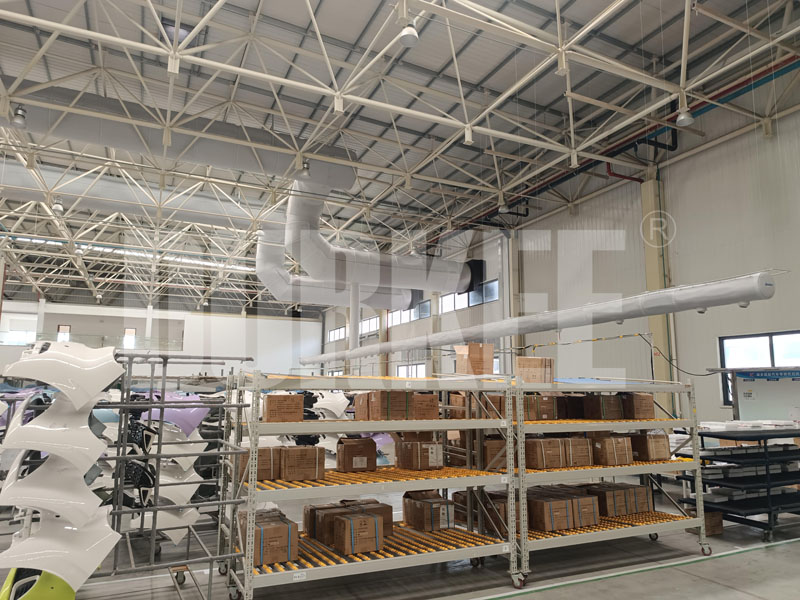 How Durkee Smart HVAC Innovations Take Center Stage at China Refrigeration 2025
How Durkee Smart HVAC Innovations Take Center Stage at China Refrigeration 2025
 Advantages and Prospects of Cloth Air Ducts
Advantages and Prospects of Cloth Air Ducts
 Fabric Duct: Innovator of Flexible Ventilation Systems
Fabric Duct: Innovator of Flexible Ventilation Systems
In the realm of facility maintenance and comfort, HVAC (Heating, Ventilation, and Air Conditioning) systems play a crucial role. Proper ventilation not only ensures optimal performance of your HVAC system but also promotes a healthy living environment. In this article, we'll explore the requirements for HVAC ventilation, with a focus on guidelines that ensure efficiency and safety.
Ventilation rules dictate how air should circulate within your facility to ensure a balanced and breathable indoor environment. Here are some fundamental principles:
1. Airflow Management: Proper ventilation requires a good balance between supply and exhaust air. Supply air brings in fresh air from outside, while exhaust air removes stale air from inside.
2. Source Control: Ventilation systems should directly address pollution sources. For example, pool ventilation systems should expel moisture and odors directly outside.
3. Ventilation Rates: Depending on the facility size and occupancy, specific ventilation rates in cubic feet per minute (CFM) must be maintained. Common spaces like office may have different requirements than less frequently used places.
4. Filtration: Adequate filters should be used to remove particulate matter from the incoming air. High-efficiency particulate air (HEPA) filters are particularly effective in removing allergens and contaminants.
5. Humidity Control: The ventilation system should maintain indoor humidity levels between 30% and 60% to prevent mold growth and maintain comfort.
Clearance requirements for hvac air sock are essential to ensure unobstructed airflow and promote system efficiency. These requirements can vary based on local codes and the type of HVAC system installed. However, some general guidelines include:
1. Distance from Obstructions: Vents should be placed where they are clear from obstructions like furniture, drapes, and electronic equipment. A recommended clearance is typically at least 6 inches.
2. Spacing Between Vents: The positioning of supply and exhaust vents should be planned to avoid short-circuiting airflow. This means they should not be placed directly opposite each other or too close together.
3. Clearance from Combustibles: For fabric duct system involving combustion (like gas furnaces), there must be sufficient clearance from combustible materials to prevent fire hazards. This is typically specified in the manufacturer's guidelines.
4. Access for Maintenance: There should be enough space around HVAC ventilation ducts and vents for easy access during maintenance and inspection. This helps in prolonging the system’s lifespan and maintaining efficiency.
5. Outdoor Vent Clearance: For vents that expel air outside, there should be a safe distance from windows, doors, and other ventilation openings to prevent back-drafting and ensure proper dispersal of exhaust air.
Determining whether your facility is properly ventilated involves several indicators:
1. Air Quality: Noticeable stale air, persistent odors, or excessive dust can signal poor ventilation. Good air quality should feel fresh and odor-free.
2. Temperature and Humidity Levels: Imbalanced temperatures between special place or unregulated humidity levels can indicate inadequate ventilation. Use a hygrometer to monitor humidity levels.
3. Moisture and Mold: Excessive condensation on windows or mold growth on walls and ceilings are signs of insufficient ventilation.
4. Air Flow: You should feel a consistent and gentle airflow when standing near vents. Weak or uneven airflow indicates potential blockages or inadequate system design.
5. Professional Inspection: Regular inspections by HVAC professionals can provide insights into whether your ventilation system is working optimally. They can check air pressure, duct integrity, and overall system balance.
To further illustrate, let's consider a situation where your facility has several musty odors despite regular cleaning. An inspection reveals that the supply and exhaust fans are not optimally balanced, leading to poor airflow. Adjusting the system to provide better circulation and possibly upgrading to a more efficient filtration system could resolve these issues.

Proper air sock ducting is essential to ensure that your facility or business remains comfortable and healthy. Adhering to ventilation rules, maintaining appropriate clearance for vents, and regularly checking for signs of poor ventilation are key to achieving optimal indoor air quality. Brand-specific guidelines, such as those from Durkduct, can provide further assistance in tailoring systems to meet individual requirements. By understanding and implementing these requirements, you can ensure your HVAC system operates efficiently, safeguarding both your health and investment.